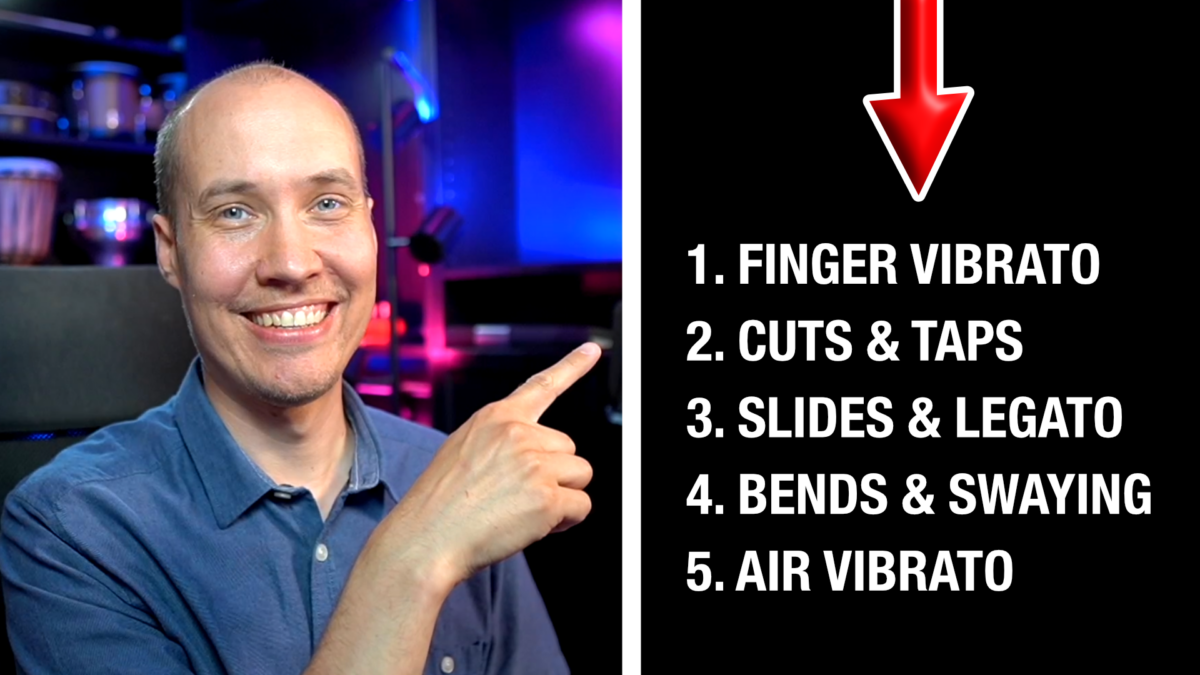 You are here because you want to improve your tin whistle playing, right?
You are here because you want to improve your tin whistle playing, right?
These techniques you will learn now are simple, yet they can add so much variation, emotion and expressive character in your performances. Here’s what you will learn:
Tin Whistle Techniques
- Finger Vibrato
- Cuts & Taps
- Slides & Legato
- Bends & Swaying
- Air Vibrato
Great, now let’s learn these amazing tin whistle techniques:
1. Finger Vibrato
Start by playing a note, let’s say the top 2 holes on your tin whistle. Then pulse on the lower holes, but skip the hole just below the note you play. Alternatively you can pulse only on the hole just below, but make sure to only shade it a bit with your finger when you do the finger vibrato.
2. Cuts & Taps
Start by covering the top 3 holes on your tin whistle, which is a G on a standard D whistle. Then blow and hold that note, and as you hold it you quickly lift your finger from the 3rd hole and quickly put it back again. That is called a “cut”. Now do the same thing again, but instead of lifting your 3rd finger, you bounce rapidly down and up on the 4th hole. That is called a “tap”. So: cut is quickly lifting the lowest hole you play and rapidly going back, tap is quickly tapping the hole below the lowest you play, and rapidly lifting. Both cuts and taps are amazing for adding spice and energy into any tune.
3. Slides & Legato
The smoothest way to connect notes in music is called legato, which means to transition between the notes in a “sliding style”. Let’s say you are going from G to A on your standard D whistle. Keep your air stream flowing, and slowly slide your lowest finger outwards and up. Can you hear how smooth and nice that note transition sounds, compared to simply lifting your finger and tonguing both notes. And you can do this in the opposite direction as well, meaning if you start on for example the A, then slowly slide your finger into the 3rd hole.
4. Bends & Swaying
If we take the slides and legato technique to the next level, it is to not transition between notes, but to sway smoothly on the note you play. Just like you can do bends on a guitar, which sounds super groovy, you can slowly bend your finger on the lowest hole you play up and down very lightly to let some air release with alters the pitch. And you can do this in the opposite way to, by playing let’s say the G (3 holes covered) and slightly angle in your finger on the 4th hole, and swaying a bit in any way you like.
5. Air Vibrato
Air vibrato is the most expressive form of vibrato, and it sounds lovely on any type of flute or wind instrument. Now the problem is that the tin whistle have a very limited dynamic range, which means you need to develop a very good level of breath control, so this is the most difficult technique to master. But the technique itself is like the others, simple on paper. You simply use your breath to slightly pulse the air pressure while you hold any note. The great thing is that you can change both the intensity and the speed of your vibrato over the duration of the note. This is why it is so incredibly expressive and beautiful.
Take Action Now – And have Fun!
Now grab you tin whistle, and practice each of these techniques one by one. And remember that these techniques are easy to learn, but hard to master. So don’t feel bad if you have a hard time adding them into a tune, I promise you that you will get there with consistent practice.
Oh, and if you want to learn how to play songs on your tin whistle, check out these videos I made for you with music notes + backing tracks:
How to Play (Notes + Backing Tracks)

